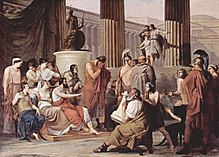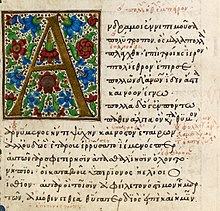Odyssey
In antiquity, Homer's authorship of the poem was not questioned, but contemporary scholarship predominantly assumes that the Iliad and the Odyssey were composed independently and that the stories formed as part of a long oral tradition.Scholars still reflect on the narrative significance of certain groups in the poem, such as women and slaves, who have a more prominent role in the epic than in many other works of ancient literature.[4] The Odyssey begins after the end of the ten-year Trojan War (the subject of the Iliad), from which Odysseus (also known by the Latin variant Ulysses), king of Ithaca, has still not returned because he angered Poseidon, the god of the sea.Telemachus learns the fate of Menelaus's brother, Agamemnon, king of Mycenae and leader of the Greeks at Troy: he was murdered on his return home by his wife Clytemnestra and her lover Aegisthus.In the course of Odysseus's seven years as a captive of Calypso on the island Ogygia, she has fallen deeply in love with him, even though he spurns her offers of immortality as her husband and still mourns for home.After the cannibalistic Laestrygonians destroyed all of his ships except his own, Odysseus sailed on and reached the island of Aeaea, home of witch-goddess Circe.Odysseus takes part in the competition, and he alone is strong enough to string the bow and shoot the arrow through the dozen axe heads, making him the winner.Once the battle is won, Telemachus also hangs twelve of their household maids whom Eurycleia identifies as guilty of betraying Penelope or having sex with the suitors.[7] The 24 books correspond to the letters of the Greek alphabet; the division was likely made after the poem's composition, by someone other than Homer, but is generally accepted.[12] The events in the main sequence of the Odyssey (excluding Odysseus's embedded narrative of his wanderings) have been said to take place in the Peloponnese and in what are now called the Ionian Islands.[13] There are difficulties in the apparently simple identification of Ithaca, the homeland of Odysseus, which may or may not be the same island that is now called Ithakē (modern Greek: Ιθάκη).[14] Both antiquated and contemporary scholars have attempted to map Odysseus's journey but now largely agree that the landscapes, especially of the Apologia (Books 9 to 11), include too many mythic aspects as features to be unequivocally mappable.[15] Classicist Peter T. Struck created an interactive map which plots Odysseus's travels,[16] including his near homecoming which was thwarted by the bag of wind.[20] Like Odysseus, Gilgamesh gets directions on how to reach the land of the dead from a divine helper: the goddess Siduri, who, like Circe, dwells by the sea at the ends of the earth, whose home is also associated with the sun.[22] In 1914, paleontologist Othenio Abel surmised the origins of the Cyclops to be the result of ancient Greeks finding an elephant skull.[23] Classical scholars, on the other hand, have long known that the story of the Cyclops was originally a folk tale, which existed independently of the Odyssey and which became part of it at a later date.[27] Agatha Thornton examines nostos in the context of characters other than Odysseus, in order to provide an alternative for what might happen after the end of the Odyssey.[29] Some of the other characters that Odysseus encounters are the cyclops Polyphemus, the son of Poseidon; Circe, a sorceress who turns men into animals; and the cannibalistic giants, the Laestrygonians.[33][34] The Phaeacians demonstrate exemplary guest-friendship by feeding Odysseus, giving him a place to sleep, and granting him many gifts and a safe voyage home, which are all things a good host should do.[38] Instead of immediately revealing his identity, he arrives disguised as a beggar and then proceeds to determine who in his house has remained loyal to him and who has helped the suitors.This is a difficult task since it is made out of a living tree that would require being cut down, a fact that only the real Odysseus would know, thus proving his identity.[54] In the 3rd and 2nd centuries BC, scholars affiliated with the Library of Alexandria—particularly Zenodotus and Aristarchus of Samothrace—edited the Homeric poems, wrote commentaries on them, and helped establish the canonical texts.[54] The first printed edition of the Odyssey, known as the editio princeps, was produced in 1488 by the Greek scholar Demetrios Chalkokondyles, who had been born in Athens and had studied in Constantinople.[57] In 2018, the Greek Cultural Ministry revealed the discovery of a clay tablet near the Temple of Zeus at Olympia, containing 13 verses from the Odyssey's 14th book.[65] Emily Wilson, a professor of classical studies at the University of Pennsylvania, notes that as late as the first decade of the 21st century, almost all of the most prominent translators of Greek and Roman literature had been men.[66] Wilson writes that this has affected the popular conception of characters and events of the Odyssey,[67] inflecting the story with connotations not present in the original text: "For instance, in the scene where Telemachus oversees the hanging of the slaves who have been sleeping with the suitors, most translations introduce derogatory language ('sluts' or 'whores') ...[23] Edith Hall suggests that Dante's depiction of Odysseus became understood as a manifestation of Renaissance colonialism and othering, with the cyclops standing in for "accounts of monstrous races on the edge of the world", and his defeat as symbolising "the Roman domination of the western Mediterranean".[79] Joyce claimed familiarity with the original Homeric Greek, but this has been disputed by some scholars, who cite his poor grasp of the language as evidence to the contrary.The novella focuses on Penelope and the twelve female slaves hanged by Odysseus at the poem's ending,[82] an image which haunted Atwood.[83] Atwood's novella comments on the original text, wherein Odysseus' successful return to Ithaca symbolises the restoration of a patriarchal system.













Odyssey (disambiguation)Homer's Odyssey (The Simpsons)Ptolemaic EgyptGeorge ChapmanEnglish translations of HomerHomeric GreekEpic poetryThe IliadDactylic hexameterWikisourceAncient Greekromanizedepic poemsGreek heroIthacaOdysseusTrojan WarPenelopeTelemachusgroup of unruly suitorsantiquitypredominantly assumesoral traditionaoidosrhapsodenostosWestern canonEnglish translationmosaicLa OlmedaPedrosa de la VegaPoseidonsuitors of PenelopeAthenaMount OlympusMentesPhemiusMentorNestorSpartaNestor's sonMenelausPharosProteusCalypsoAgamemnonMycenaeClytemnestraAegisthusCharles GleyreNausicaäOgygiaHermesScherieAlcinousDemodocusTrojan HorseFrancesco HayezCiconeslotus-eatersCyclopesPolyphemusAeolusLaestrygonianssacrificed to the deadTiresiaslivestock of HeliosAnticleiaSiren PainterBritish MuseumSirensScyllaCharybdisHeliosJohn William WaterhouseEumaeusAntinousThesprotiaEurycleiaThomas DegeorgeLaertesEupeithesJohn Rhososin medias resflashbacksGreek alphabetClassical periodTelemachyEpic CycleTelegonyHomer's IthacaGeography of the Odysseyembedded narrativePeloponneseIonian IslandsIsmarosPeter T. StruckHumbabaMartin WestEpic of GilgameshGilgameshSiduripaleontologistOthenio Abelfolk taleUniversity of CologneOrestesAchillesEurymedoncannibalisticAncient Agora of Athenstype sceneJohann Heinrich Wilhelm TischbeinPhoenician alphabetclay cupIschiaCalvert WatkinsNestor's golden cupPeisistratosPanathenaiaDomenico GhirlandaioDemetrios Chalkokondylesschool textsAristotleLibrary of AlexandriaZenodotus